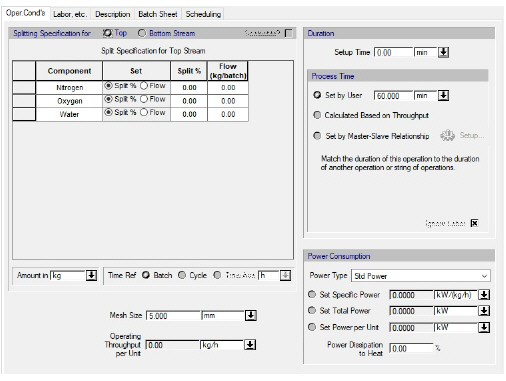

The following table shows a brief description of the variables appearing in this tab. The table also displays their default values and their generally acceptable range:
|
Variable |
Default Value |
Range |
|
|
||
|
○ Split (%) |
0.0 |
0 – 100 |
|
○ Amount (kg) |
0.0 |
Positive |
|
○ Scaleable |
Yes |
Yes/No |
|
● Operating Throughput per Unit (kg/h) |
0.0 |
Positive |
|
○ Mesh Size (mm) |
5.0 |
Positive |
|
|
|
|
|
○ Setup Time (min) |
0.0 |
Positive |
|
◙ Process Time (min) |
60.0 |
Positive |
|
○ Ignore Labor? |
Yes |
Yes/No |
|
○ Power Type |
<Std Power> |
Any Power Type |
|
◙ Specific Power (kW/(kg/h)) |
0.0 |
Positive |
|
◙ Total Power (kW) |
0.0 |
Positive |
|
◙ Power Per Unit (kW) |
0.0 |
Positive |
|
○ Power Dissipation to Heat (%) |
0.0 |
[0,100] |
Symbol Key: ○ User-specified value (always input); ● Calculated value (always output); ◙ Sometimes input, sometimes output
The following list describes the available specification choices in this tab; for more details on how these are implemented, see Vibrating Screening: General Description.
•Splitting Options...
For each component present in the feed stream check the Set Split (%) or the Set Amt. options and specify its fraction or mass amount in each output stream.
•Duration...
The duration controls appear only if the procedure in batch mode. In Rating Mode, you have a choice to either set the process time (and the setup time) or to allow the process time to be specified (based on the throughput). In Design mode, you must specify the process time (and the setup time) in order for the program to calculate the rated throughput.
You can set the process time (cooling time), or have the process time calculated based on cooling rate, or match the duration of this operation to the duration of another operation by introducing a master-slave relationship between the two operations. There are two options for specifying the cooling rate: you can either specify a constant cooling rate or an exponential cooling rate (specify the overall UA). If you introduce a master-slave relationship, the program will match the setup time, the process time and the turnaround time of this operation (the ‘slave’) with the corresponding times of the reference operation (the ‘master’ operation). For more details on how to setup a master-slave relationship, see The Scheduling Tab